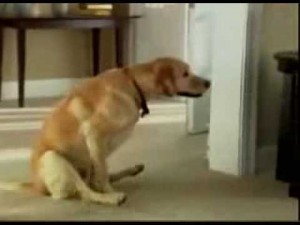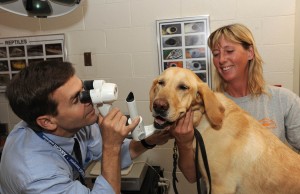Archive for May, 2012
Is your dog a “scooter?”
 If your dog sits on her behind and then drags her rear across the floor, she’s probably itchy. One of two things may be going on. One of the most common causes of an itchy bottom in dogs is a clogged anal gland. When your dog defecates, her anal glands deposit secretions on the stool. These secretions help other dogs recognize who your dog is, her age and her gender. Sometimes those glands get clogged and need to be taken care of by a veterinarian. Another possible reason for bottom scooting dogs is tapeworm. If you notice worm segments, that look like small grains of rice in your dog’s feces, bring a stool sample to your veterinarian for testing.
If your dog sits on her behind and then drags her rear across the floor, she’s probably itchy. One of two things may be going on. One of the most common causes of an itchy bottom in dogs is a clogged anal gland. When your dog defecates, her anal glands deposit secretions on the stool. These secretions help other dogs recognize who your dog is, her age and her gender. Sometimes those glands get clogged and need to be taken care of by a veterinarian. Another possible reason for bottom scooting dogs is tapeworm. If you notice worm segments, that look like small grains of rice in your dog’s feces, bring a stool sample to your veterinarian for testing.
Remember, your pets count!
Puppy vaccinations
 Your puppy’s first vaccinations helps him build up immunity to disease. What shot should he get? Most puppies receive the rabies shot as well as a combination vaccine that’s called DHLPP. They’re administered as a series of shots. This vaccine guards your pup against distemper, hepetitis, leptospirosis, para-influenza and parvovirus. In order to keep his immunity up, your dog will probably get these shots once a year for the rest of his life. Talk to your veterinarian about what’s best for your pet. Some vets recommend that adult dogs get vaccinated less frequently. Depending upon where you live and where you are planning to take your dog, your pet may also need to be vaccinated against corona, lyme, kennel cough and giardia.
Your puppy’s first vaccinations helps him build up immunity to disease. What shot should he get? Most puppies receive the rabies shot as well as a combination vaccine that’s called DHLPP. They’re administered as a series of shots. This vaccine guards your pup against distemper, hepetitis, leptospirosis, para-influenza and parvovirus. In order to keep his immunity up, your dog will probably get these shots once a year for the rest of his life. Talk to your veterinarian about what’s best for your pet. Some vets recommend that adult dogs get vaccinated less frequently. Depending upon where you live and where you are planning to take your dog, your pet may also need to be vaccinated against corona, lyme, kennel cough and giardia.
Remember, your pets count!
Leptospirosis
 Leptospirosis is a potentially deadly bacterial infection that’s spread by the urine of infected animals. It can damage a dog’s liver and kidney. Symptoms include soreness, lethargy and fever. An infected dog may also vomit and have bloody urine. There is a vaccine available but it does not protect against all strains of Leptospirosis. Always keep your dog away from stagnant water and rodents and watch for flu like symptoms. If your dog does become infected, your veterinarian will likely administer penicillin to clear up the bloodstream and then after the kidneys recover, he’ll give your dog a course of drugs called tetracycline. The dog may become dehydrated so intravenous fluids may also be needed.
Leptospirosis is a potentially deadly bacterial infection that’s spread by the urine of infected animals. It can damage a dog’s liver and kidney. Symptoms include soreness, lethargy and fever. An infected dog may also vomit and have bloody urine. There is a vaccine available but it does not protect against all strains of Leptospirosis. Always keep your dog away from stagnant water and rodents and watch for flu like symptoms. If your dog does become infected, your veterinarian will likely administer penicillin to clear up the bloodstream and then after the kidneys recover, he’ll give your dog a course of drugs called tetracycline. The dog may become dehydrated so intravenous fluids may also be needed.
Remember, your pets count!
What if you miss giving your dog his heart worm medication?
 Heart worm is a disease spread by mosquitoes. Your dog could be at risk if you live in an infested area. Your veterinarian may recommend a monthly preventative heart worm medication, administered regularly until your vet tells you that it’s safe to stop for the winter. If you forget to give your dog his heart worm medication one month, call your vet. He’ll likely recommend that you give your dog his pill as soon as you’ve recognized that you’ve missed it and then continue as normal next month. Usually missing one dose is not a problem. If you forget for two consecutive months, your dog may be susceptible to heart worm. As ask your veterinarian to check him out.
Heart worm is a disease spread by mosquitoes. Your dog could be at risk if you live in an infested area. Your veterinarian may recommend a monthly preventative heart worm medication, administered regularly until your vet tells you that it’s safe to stop for the winter. If you forget to give your dog his heart worm medication one month, call your vet. He’ll likely recommend that you give your dog his pill as soon as you’ve recognized that you’ve missed it and then continue as normal next month. Usually missing one dose is not a problem. If you forget for two consecutive months, your dog may be susceptible to heart worm. As ask your veterinarian to check him out.
How your dog sees
 A dog’s sense of smell is stronger than ours but what about his vision? In low light, he can see about three times better than you can because his pupil’s are large and he has many more cones in his retina. Cones have higher light levels. A dog’s peripheral sight is better than ours too. His field of vision covers about 250 degrees. Humans see sharper than dogs and we also see colors better than our best friends. What your dog sees at 20 feet, you can see clearly from 75 feet. Canine eyes lack one of the three sets of color receptors that are found in human eyes. Dogs can only see blues and yellow not reds and greens.
A dog’s sense of smell is stronger than ours but what about his vision? In low light, he can see about three times better than you can because his pupil’s are large and he has many more cones in his retina. Cones have higher light levels. A dog’s peripheral sight is better than ours too. His field of vision covers about 250 degrees. Humans see sharper than dogs and we also see colors better than our best friends. What your dog sees at 20 feet, you can see clearly from 75 feet. Canine eyes lack one of the three sets of color receptors that are found in human eyes. Dogs can only see blues and yellow not reds and greens.
Remember, your pets count!
Glaucoma in a dog
 Glaucoma is disease that many dog owners notice when it’s too late. This condition is caused by a build up of fluid in the eye and is one of the main causes of canine blindness. Glaucoma strikes about one in every 200 dogs. Some breeds are more susceptible to it than others. High risk breeds include ,cocker spaniels ,terriers, bassett hounds and beagles. Symptoms of glaucoma are hard to spot but early diagnosis is critical in preventing blindness. Some signs of the disease include glassiness, cloudiness or redness in a dog’s eye. Other symptoms include teary eyes, sensitivity to light or a dilated pupil. If you notice any of these problems in your dog, have him checked out by a veterinarian.
Glaucoma is disease that many dog owners notice when it’s too late. This condition is caused by a build up of fluid in the eye and is one of the main causes of canine blindness. Glaucoma strikes about one in every 200 dogs. Some breeds are more susceptible to it than others. High risk breeds include ,cocker spaniels ,terriers, bassett hounds and beagles. Symptoms of glaucoma are hard to spot but early diagnosis is critical in preventing blindness. Some signs of the disease include glassiness, cloudiness or redness in a dog’s eye. Other symptoms include teary eyes, sensitivity to light or a dilated pupil. If you notice any of these problems in your dog, have him checked out by a veterinarian.
Remember, your pets count!
How to prepare your pet for a new baby
 If your dog or cat has been your only baby for years, and now you’re bringing home a new baby, you’ll have to prepare your pet. A few weeks before the baby arrives, start spending less time with your pet. Allow him to smell the lotions and powder in the baby’s nursery but don’t let him on the crib or blanket. You can also play recorded baby noises. When your baby comes home, first greet your pet empty handed, then sit in a chair with your baby and cover her head with your hand. Let your pet sniff, but not lick. Before you know it, they’ll be best buddies but never leave the two alone together. Remember to give your pet plenty of attention once your baby is home.
If your dog or cat has been your only baby for years, and now you’re bringing home a new baby, you’ll have to prepare your pet. A few weeks before the baby arrives, start spending less time with your pet. Allow him to smell the lotions and powder in the baby’s nursery but don’t let him on the crib or blanket. You can also play recorded baby noises. When your baby comes home, first greet your pet empty handed, then sit in a chair with your baby and cover her head with your hand. Let your pet sniff, but not lick. Before you know it, they’ll be best buddies but never leave the two alone together. Remember to give your pet plenty of attention once your baby is home.
Remember, your pets count!
Why do cats have those little folds or pockets behind their ears?
 A cat has three components to their ear much like a human ear. The outer ear, the middle ear and the inner ear. The pocket or little fold behind a cats ear is actually the outside edge of the outer ear. It’s called the pinna. The outer ear is pyramid shaped and is completely external on the cat’s head. This pocket or fold gives a cat their exceptional hearing ability. The pinna has two functions, it funnels sound into the ear canal in the middle ear and it also helps the ear’s flexibility and rotates up to 180 degrees to help pinpoint and funnel sounds to the ear.
A cat has three components to their ear much like a human ear. The outer ear, the middle ear and the inner ear. The pocket or little fold behind a cats ear is actually the outside edge of the outer ear. It’s called the pinna. The outer ear is pyramid shaped and is completely external on the cat’s head. This pocket or fold gives a cat their exceptional hearing ability. The pinna has two functions, it funnels sound into the ear canal in the middle ear and it also helps the ear’s flexibility and rotates up to 180 degrees to help pinpoint and funnel sounds to the ear.
Remember, your pets count!
Cats and Babies
 There always have been many misconceptions about having a baby and owning a cat. Some people really believe that cats are not good for a baby’s health. There was a study done at the Henry Ford Hospital in Detroit and they found that children that were exposed to cats as infants grew up to have significantly fewer allergies then kids without pets. The study indicates that if you have a cat around at the beginning of a child’s life, they may develop a strong immune system. Another myth that I’m sure you’ve heard is that cats try to harm infants. This is not the case but I wouldn’t recommend a cat sleeping with a baby unsupervised. The reason is that babies can’t always turn themselves. If the cat gets close enough, the baby may have trouble breathing. I would let the baby sleep alone.
There always have been many misconceptions about having a baby and owning a cat. Some people really believe that cats are not good for a baby’s health. There was a study done at the Henry Ford Hospital in Detroit and they found that children that were exposed to cats as infants grew up to have significantly fewer allergies then kids without pets. The study indicates that if you have a cat around at the beginning of a child’s life, they may develop a strong immune system. Another myth that I’m sure you’ve heard is that cats try to harm infants. This is not the case but I wouldn’t recommend a cat sleeping with a baby unsupervised. The reason is that babies can’t always turn themselves. If the cat gets close enough, the baby may have trouble breathing. I would let the baby sleep alone.
Remember, your pets count!
Coping with the loss of a pet
 The loss of your beloved pet can be devastating. For most of us, our pets are not just animals, they are beings who occupy a special place in our hearts. When our dog or cat dies, something of ourselves is also lost. As a pet owner, you may need to have your grief affirmed. Pet sympathy cards are now widely available and some veterinary colleges have hot lines where bereaved pet owners can find a kind, understanding voice and a sympathetic ear. Most of the hotline volunteers are veterinary students who receive special training in grief counseling. If you have a child who is dealing with the death of a pet, you can help them cope by talking to them about their loss. Share some of their precious memories together and in time, their grief will diminish.
The loss of your beloved pet can be devastating. For most of us, our pets are not just animals, they are beings who occupy a special place in our hearts. When our dog or cat dies, something of ourselves is also lost. As a pet owner, you may need to have your grief affirmed. Pet sympathy cards are now widely available and some veterinary colleges have hot lines where bereaved pet owners can find a kind, understanding voice and a sympathetic ear. Most of the hotline volunteers are veterinary students who receive special training in grief counseling. If you have a child who is dealing with the death of a pet, you can help them cope by talking to them about their loss. Share some of their precious memories together and in time, their grief will diminish.
Remember, your pets count!